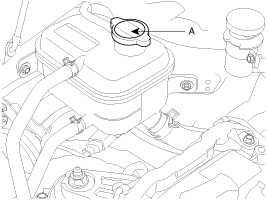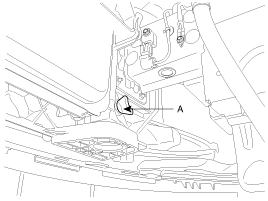Remove the radiator cap (A).

Never remove the radiator cap when the engine is hot.
Serious scalding could be caused by hot fluid under high pressure escaping from the radiator.
When pouring engine coolant, be sure to shut the relay box lid and not to let coolant spill on the electrical parts of the paint. If any coolant spills, rinse it off immediately.
Slide the heater temperature control lever to maximum heat. Make sure the engine and radiator are cool to the touch.
Remove the radiator cap (A).

Loosen the drain plug (A), and drain the coolant.

Tighten the radiator drain plug (A) securely.
Remove the coolant reservoir tank. Drain the coolant and reinstall the coolant reservoir tank. Fill the coolant reservoir tank to the MAX mark with the coolant.
Fill fluid mixture (coolant 5: water 5) with coolant and water slowly through the radiator cap. Gently squeeze the upper/ lower hoses of the radiator so as to bleed air easily.
Use only genuine antifreeze/coolant.
For best corrosion protection, the coolant concentration must be maintained year-round at 50% minimum. Coolant concentrations less than 50% may not provide sufficient protection against corrosion of freezing.
Coolant concentrations greater then 60% will impair cooling efficiency and are not recommended.
Do not mix different brands of antifreeze/coolants.
Do not use additional rust inhibitors or antirust products; they may not be compatible with the coolant.
Start the engine and allow coolant to circulate. When the cooling fan operates and coolant circulates, refill coolant through the radiator cap.
Repeat 7 until the cooling fan 3 ~ 5times and bleed air sufficiently out of the cooling system.
Fill the reservoir to the "MAX" line with coolant.
Stop the engine and allow coolant to be cool.
Repeat step 6 to 10 until the coolant level stays constant and all air is bleed out of the cooling system.
Recheck the coolant level in the reservoir tank for 2 ~ 3 days after replacing coolant.
Coolant capacity : 6.3 liters(6.66 US qt, 5.54 lmp qt)